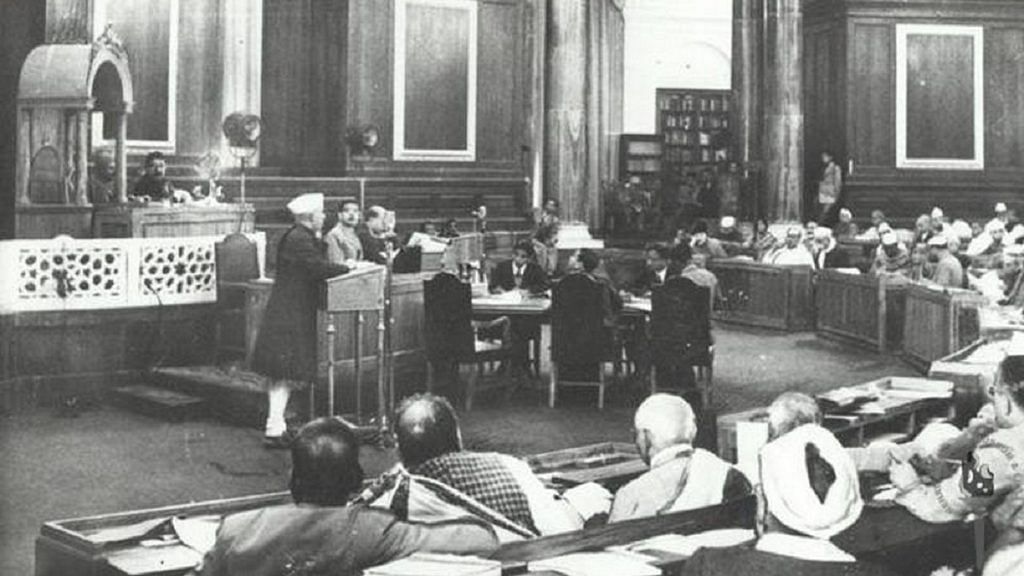Constituent Assembly debated Section 124A’s offensive nature and the possibility that it will be misused to jail government’s critics.
While India’s Constitution has been amended a record 103 times since its birth over 70 years ago, succeeding generations of lawmakers have not once deemed it fit to bring in a provision in this historic document and remove the blot that tarnishes its founders’ legacy: Section 124A of the Indian Penal Code or the draconian sedition law.
That leads us to the question: How did the Constituent Assembly debate the controversial issue of sedition?
Also read: Why BJP and Congress love to hate sedition (till they come to power)
A colonial law meant to suppress Indians
It is nothing short of remarkable that India’s founding leaders ensured that Section 124A was not and is not part of the Constitution.
They understood the perils of making sedition ‘a reasonable restriction’ on the freedom of speech and expression under Article 13 of the draft Constitution, but it continues to be a criminal offence.
And, the Constituent Assembly vigorously debated the offensive nature of this law and the possibility that it will be misused to jail those critical of the government—the only reason the British wove it into the IPC in 1870.
Constitution without ‘sedition’
The contentious law had been, for long, employed to imprison freedom fighters including Mahatma Gandhi, and on 1 December 1948, Congress leader and educationist K.M. Munshi, a key voice in the Constituent Assembly, said that there should be no room for ‘sedition’ in independent India.
He argued: “Now that we have a democratic Government a line must be drawn between criticism of Government which should be welcome and incitement which would undermine the security or order on which civilized life is based, or which is calculated to overthrow the State. Therefore, the word ‘sedition’ has been omitted. As a matter of fact the essence of democracy is criticism of Government.”
While key founding leaders opposed the draconian law, the real credit for sedition not finding a place in the Constitution goes to Sikh leader Bhupinder Singh Mann.
Mann, who represented East Punjab in the Constituent Assembly, made a case for upholding liberty—and appealed to them to vote against embedding sedition into the Constitution.
Mann said he regarded freedom of speech and expression as the very life of civil liberty. He reminded other members:
“For the public in general, and for the minorities in particular, I attach great importance to association and to free speech. It is through them that we can make our voice felt by the Government, and can stop the injustice that might be done to us. For attaining these rights, the country had to make so many struggles, and after a grim battle succeeded in getting these rights recognised. But now, when the time for their enforcement has come, the Government feels hesitant; what was deemed as undesirable then is now being paraded as desirable. What is being given by one hand is being taken away by the other. Every clause is being hemmed in by so many provisos… You want to continue the old order so that there should be no opportunity of a trial, of putting up defence and of an appeal.”
Also read: When a Facebook post almost got Arun Jaitley tried for sedition
Urging fellow members to vote against the law, he said:
“…all opposition that is peaceful and not seditious should get full opportunity, because opposition is a vital part of every democratic Government. To my mind, suppression of lawful and peaceful opposition means heading towards fascism.”
Upon Gobind’s proposition, the Speaker of the Constituent Assembly, Seth Govind Das, delivered an even more forceful argument on this count.
Das came from a family that was proud to be pro-monarchy, having received several grants and jagirs for its service to the crown. However, a leading participant in the Satyagraha movement, Das himself had been jailed by the British for committing sedition.
He emphasised that neither titles, nor sedition had a place in free India.
“My grandfather held the title of Raja and my uncle that of Diwan Bahadur and my father too that of Diwan Bahadur. I am very glad that titles will no more be granted in this country. In spite of belonging to such a family I was prosecuted under Section 124 A and that also for an interesting thing. My great grandfather had been awarded a gold waist-band inlaid with diamonds. The British Government awarded it to him for helping it in 1857 and the words, “In recognition of his services during the Mutiny in 1857” were engraved on it. In the course of my speech during the Satyagraha movement of 1930, I said that my great-grandfather got this waist-band for helping the alien government and that he had committed a sin by doing so and that I wanted to have engraved on it that the sin committed by my great-grandfather in helping to keep such a government in existence had been expiated by the great-grandson by seeking to uproot it. For this I was prosecuted under Section 124 A and sentenced to two years’ rigorous imprisonment.”
It is worth remembering that attempts to weave ‘sedition’ into Article 13 as a reasonable restriction on the freedom of speech and expression were defeated owing to these powerful arguments of our country and Constitution’s founding leaders.
But successive elected Indian governments have happily—and indiscriminately—used the offending clause to throttle voices critical of them.
And, despite several judicial pronouncements, the draconian sedition law continues to be applied to Indian citizens without proper application of mind.
